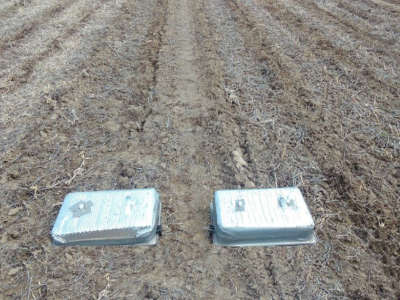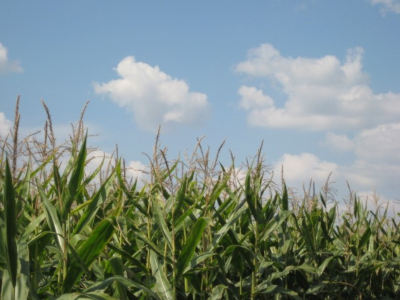For corn, using dairy manure and legume cover crops in crop rotations can reduce the need for inorganic nitrogen fertilizer and protect water quality, but these practices also can contribute to emissions of nitrous oxide — a potent greenhouse gas.
That is the conclusion of Penn State researchers, who measured nitrous oxide emissions from the corn phases of two crop rotations — a corn-soybean rotation and a dairy forage rotation — under three different management regimens. The results of the study offer clues about how dairy farmers might reduce the amount of nitrogen fertilizer they apply to corn crops, saving money and contributing less to climate change.
The results are important because although nitrous oxide accounts for just 7% of U.S. greenhouse gas emissions, it is significantly more potent than carbon dioxide or methane when it comes to driving climate change, according to Heather Karsten, associate professor of crop production/ecology in the College of Agricultural Sciences. Nitrous oxide is almost 300 times more powerful than carbon dioxide and remains in the atmosphere for more than 100 years.
“This research suggests that all nitrogen inputs — manure, legumes and fertilizer — contribute to nitrous oxide emissions,” she said. “But farmers could reduce nitrous oxide emissions if they could apply manure after the crop is planted, closer to when the corn begins to take up nitrogen.
"And if they could apply manure only when the crop needs it by “side-dressing,” she added, "they likely could use less inorganic nitrogen fertilizer. But equipment for side-dressing manure into a growing corn crop is not yet widely available."

Using measuring chambers like those shown here, researchers found that nitrous oxide emissions peaked a few weeks after manure was applied and for a short period after fertilizer was applied. Identifying how to time organic nitrogen amendments with corn uptake represents an opportunity to reduce nitrous oxide emissions from dairy production systems, the researchers said.
Researchers compared the effects of three management treatments for no-till corn and measured nitrous oxide emissions throughout the corn growing season. In the corn-soybean rotation, the team compared nitrous oxide emissions from broadcasting dairy manure, shallow disk manure injection, and the application of inorganic fertilizer in the form of liquid urea ammonium nitrate.
Manure was applied before corn was planted, as most farms do, while in the inorganic fertilizer treatment, fertilizer was applied according to recommended practices — when the corn was growing and taking up nitrogen.
This better timing for nitrogen application allowed for a reduced total nitrogen application, and the nitrous oxide emissions were lower than with the injected manure treatment. Injecting manure increased nitrous oxide emissions compared to the broadcast manure treatment in one year of the study, indicating that the environmental and nitrogen-conservation benefits of injection should be weighed against the additional emissions when selecting the practice.
The researchers also compared nitrous oxide emissions from corn grown for silage or grain in the no-till, six-year, dairy forage rotation in which corn followed a two-year, mixed alfalfa and orchardgrass forage crop and also a crimson clover cover crop. Manure also was broadcasted before corn planting, and nitrous oxide emissions were compared to the rotation in which corn was planted after soybean with broadcast manure. The nitrous oxide emissions during the corn season didn’t differ among the three prior legume treatments.
In both experiments, nitrous oxide emissions peaked a few weeks after manure was applied and for a short period after fertilizer was applied. Since nitrous oxide emissions are influenced by factors that influence microbial processes, the researchers examined what environmental and nitrogen-availability factors were most predictive of nitrous oxide emissions. Increasing temperatures spurring corn growth and factors that influence soil nitrogen availability were important factors in both comparisons.

The researchers measured nitrous oxide emissions from the corn phases of two crop rotations — a corn-soybean rotation and a dairy forage rotation — under three different management regimens.
The study shows that nitrogen availability from organic inputs such as manure and legume cover crops can contribute to nitrous oxide emissions from corn, noted lead researcher Maria Ponce de Leon, former graduate student in Karsten’s research group, now a doctoral candidate at the University of California, Davis. Identifying how to time organic nitrogen amendments with corn uptake represents an opportunity, she said, to reduce nitrous oxide emissions from dairy production systems.
Now, dairy farmers apply manure mostly prior to planting corn, and as the manure and the organic legume biomass from the cover crop decompose, the nitrogen content builds in the soil. Some of it can be lost as nitrous oxide emissions or leach into groundwater.
“Until the corn is rapidly taking up nitrogen from the soil, there’s potential for both of those environmental losses,” Ponce de Leon said. “If we could better synchronize the timing of the manure application to when the corn is growing and taking up nitrogen, we could reduce nitrous oxide missions. That also would help the crop and the farmer better capture the nitrogen that’s available in that manure.”
The research, recently published in Nutrient Cycling in Agroecosystems, was conducted at Penn State’s Russell E. Larson Agricultural Research Center as part of the much larger “Dairy Cropping Systems” project that has been underway for more than a decade. Initiated in 2010, that parent project aims to sustainably produce the forage and feed for a typical 65-cow, 240-acre dairy farm in Pennsylvania.
Curtis Dell, soil scientist with the U.S. Department of Agriculture’s Agricultural Research Service Pasture Systems and Watershed Management Research Unit, contributed to the research.
Source : psu.edu